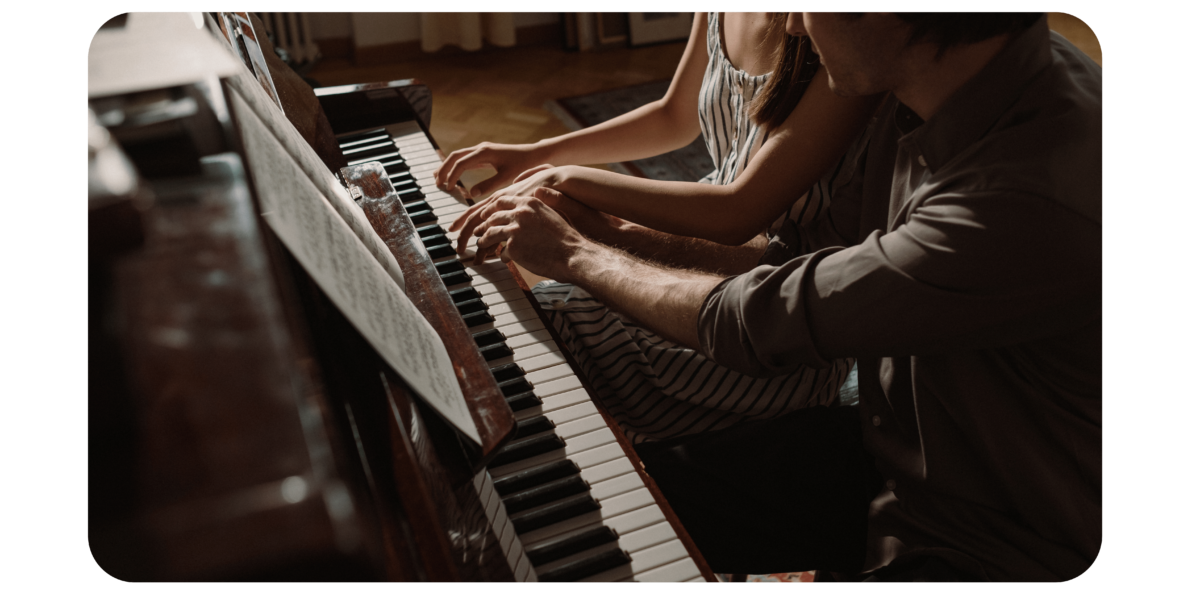Piano Accompaniment and How to Master It

This article spotlights the accompaniment instead of the leading musician. We teach you some piano accompaniment patterns and help you get better at playing them.
The piano is the ultimate wingman. It makes you sound outstanding when you want to sing a vocal ballad or smash out a saxophone solo.
Because of the piano’s wide dynamic range and infinite chordal options, it is a diverse and reliable partner for telling your story and playing your music.
But there are challenging accompaniment elements: figuring out what rhythms and patterns to play, how to play with confidence but still maintain a supporting role, and some others that we’ll dive into today.
What is piano accompaniment?
The lead ultimately carries the song’s message or essence. But the accompaniment creates the atmosphere and sets the scene for the story to unfold.
Piano accompaniment comprises a range of techniques, patterns, and combinations from which you can choose to create the perfect vibe for your song. The key (pun intended) is not to get stuck in these structures: they are learning tools for compiling your language and refining a unique sound.
Piano accompaniment patterns.
Time to learn some ABCs of piano accompaniment so you can learn to speak on your own! Here are three techniques, from easy to advanced.
1: Block chords accompaniment
Chords are the foundation of all piano accompaniment. The lead singer or instrument usually only sings or plays single-line melodies, so it is up to the piano to provide all harmonic contexts.
The simplest way to play chords is in blocks. This means playing basic triads (three-note chords) or seven chords (four notes) in the right hand to a simple and repetitive rhythmic pattern. In 4/4, this might be one chord on every quarter note. In 6/8, you could play one chord on each dotted quarter note with subtle embellishments. If you want to spice it up a bit, you could use syncopation by placing some chords on the off beats.
In the left hand, you can play the bass notes of the chords in octaves, with the fifth in the middle. The rhythm of the left-hand part varies, but is often just one long, held note on the first beat of every bar. If the song is funkier and up-tempo, the left hand should play a groovy bass line.
For block chords, it’s extra important to understand chord inversions. This is when the notes of a chord are rearranged into a different order, and you can learn more about them with these 10 Piano Exercises for Beginners.
This allows for good voice-leading, the art of playing a chord progression without moving your hand too much. Inversions provide so many voice-leading options that you could play them all within one octave of the piano. Here is an example of a four-chord voice-lead progression that would sound great in a block chords piano accompaniment:

2: Broken chords accompaniment
There’s nothing that you need to fix about broken chords. They sound amazing! But we call them broken chords because they involve separating a chord’s notes and playing them one after another in a specific pattern.
The beauty of broken chords is that they have a rich harmonic sound but also subtle and supportive melodies interwoven through them. This is where inversions and voice-leading also become relevant in broken chords – they give you flexibility and variety in your note choices.
Broken chords are a great place to get creative. Pick your favorite chords, tear them apart, and experiment with different patterns and combinations of the notes in any time signature. Are you ready for some of our favorite broken chord patterns? We’ve even given them special names to help you remember them.
*L = Low, H = High. The other notes in the chord are no higher than H1 and no lower than L1.
“One step backward”
This is a beautiful pattern that creates a mystical and emotional vibe. Perfect for a major seven chord at the beginning of a song.
Think Alicia Keys.
Time signature: 4/4
Note length: eighth notes
Pattern:
(L)1, 5, (H)1, 5, 7, (H)1, 5
Example with Gmaj7:
(L)G, D, (H)G, D, F#, D, (H)G, D
“Spiral stairs”
This is a Bon Iver-style meditative pattern, great for a chord progression that allows for an ascending voice-lead line. Depending on how you play it, it can build tension or create a dreamy sound.
Time signature: 4/4
Note length: sixteenth notes
Pattern:
[5, (L)1, 2, 3] x3 → 7, (H)1, 2, 3
Example with F major:
[C, (L)F, G, A] x3 → E, (H)F, G, A
“Pendulum”
An eerie and contemplative broken chord pattern is great for theatrical songs.
Time signature: 6/8
Note length: eighth notes
Pattern:
(L)1, 3, 5, (H)1, 5, 3
Example with A minor:
(L)A, C, E, (H)A, E, C
3: Counterpoint accompaniment
A counterpoint is when two or more moving melodies interact with one another. It is a technique common amongst classical composers, who arranged the music so that different instruments could have a musical conversation using their melodies. In the context of accompaniment, counterpoint means playing a piano part with a melody that weaves in and out of the singer or solo instrument’s lead melody.
This is a more complicated style of piano accompaniment. In addition to a deep understanding of harmony and form, you need to have strong melodic instincts. But there are small contrapuntal ideas that you can use to decorate your block or broken chord accompaniment pattern. This technique is very song-specific, so we can’t give you precise patterns, but here are a couple of tips:
- Play an exact harmony, for example, a third above the melody. You don’t want to play this the whole time because it will make the piano sound more like a backing vocalist than an accompaniment. But it provides a beautiful moment of catharsis and sweetness when you use it well.
- Try a call and response. There are usually breaths or spaces in the melody, which are great moments for the piano accompaniment to reprise a melodic refrain from earlier in the song or even directly repeat the most recent phrase, like a parrot. Remember that the accompaniment is a balancing force in the music: if the lead melody poses a question, respond with the answer. If the lead melody resolves the tension, use the accompaniment to open up a new question.
- Create a hook. This is especially important if the melody contains many notes and a lot of movement. An instrumental hook in the accompaniment will make the melody more grounded and digestible. It can be a short groovy rhythm or an uplifting melodic phrase.
Tips for piano accompaniment.

Less is more
Paradoxically, the accompanists who stand out most are the ones who don’t try to. Remember that you are there to serve something bigger than yourself – not the lead musician but the music itself. Stay true to that intention, to play the music with as much clarity and honesty as possible. If you do, you will find that playing piano accompaniment is simple, minimalistic, but incredibly deep and fulfilling. Your role is to create a safe and inspiring musical environment where the lead singer can communicate the story’s message.
Express yourself
The flip-side of “less is more” is that you don’t want to make yourself small or be lazy. If the accompanist is sleepy, bored, or feeling insecure and restrained, then the whole energy of the music will fall. Part of your role as an accompanist is to lift the spirits and throw sparks of inspiration into the music when the lead musician’s energy is falling. So be yourself! Choose moments to be spontaneous, make a statement, or throw a new sound into the mix.
Learn your major scales
This is a pro-tip for those serious about being a piano accompanist. Being thoroughly familiar with your major scales is an essential skill, allowing you to change the song’s key to suit the range of the lead musician. When you’re accompanying a singer at a cocktail bar, and she says, “Hey, can we do Eleanor Rigby in G minor tonight?” you want to be able to say, “Of course, no sweat” – as opposed to going to the bathroom and sweating profusely because you only know the song in D minor. You can practice your major scales and some more advanced major modes with this Guide to Major Modes.
Want some piano accompaniment?
Looking for some company while you learn to accompany on the piano? Download the Simply Piano app for step-by-step and interactive guidance in learning chords, inversions, scales, and everything else you need to know to master piano accompaniment.









